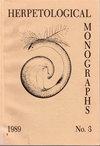东莫哈韦沙漠中沙漠象龟的活动范围和大小
IF 1.1
2区 生物学
Q3 ZOOLOGY
引用次数: 66
摘要
我们对内华达州拉斯维加斯附近沙漠龟保护中心附近的一个自然种群的自由放养沙漠象龟构建了最小凸多边形(MCP)家域。家域面积估计与莫哈韦沙漠和索诺兰沙漠的其他沙漠象龟的家域面积估计没有显著差异。本研究与Burge(1977)和Barrett(1990)的研究结果进行了综合统计分析,结果表明,雄性陆龟的活动范围明显更大,变化更大。MCP多边形区域的Bootstrap分析表明,尽管重新捕获的平均间隔为3.2天,但乌龟的发现存在显著的自相关性,这违反了几乎所有家园范围估计技术的假设,并且容易低估真实的家园范围面积。延长两次捕获之间的间隔将严重限制在单个活动季节中可以在单个乌龟身上获得的点数。我们还创建了“肉眼”最小多边形,以便与相同乌龟的MCP进行比较。这一比较表明,沙漠陆龟的MCP包括没有证据表明陆龟使用它们的地区,这是其总面积的很大一部分(12-56%,平均= 35%)。观察的间隔随着动物的性别(雄性或雌性)和上一次观察的间隔而变化。移动距离近似呈指数分布,短距离移动比长距离移动更常见,容易使沙漠象龟的家园范围估计自相关。我们强烈要求考虑将活动范围作为龟所穿越区域大小的指标,以及不同个体、性别和/或种群的活动模式,而不是强调将区域作为动物的资源或特征的生物学解释。本文章由计算机程序翻译,如有差异,请以英文原文为准。
Home Range Size and Movements by Desert Tortoises, Gopherus agassizii, in the Eastern Mojave Desert
We constructed minimum convex polygon (MCP) home ranges for free-ranging desert tortoises from a natural population adjacent to the Desert Tortoise Conservation Center, near Las Vegas, NV. Home range area estimates were not significantly different from those estimated for other desert tortoises in the Mojave and Sonoran deserts. Male tortoises had significantly larger and more variable home ranges in a combined statistical analysis of this study with those of Burge (1977) and Barrett (1990). Bootstrap analysis of the MCP polygon areas suggested substantial autocorrelation of the tortoise sightings despite a mean interval between recaptures of 3.2 days, violating an assumption of nearly all home range estimation techniques and predisposing to underestimation of the true home range area. Extending the interval between recaptures would severely limit the number of points that could be obtained on an individual tortoise in a single activity season. We also created "by eye" minimum polygons to compare with MCP's for the same tortoises. This comparison suggests that MCP's for desert tortoises include, as substantial fractions of their total area (12-56%, mean = 35%), areas with no evidence that tortoises use them. Movements between resightings vary with the sex of the animal (male > female) and interval since previous sighting. The distance of movements was approximately exponentially distributed, with short movements more common than longer movements, predisposing home range estimates for desert tortoises to be autocorrelated. We urge the consideration of home range as an indicator of size of the areas traversed by a tortoise and the patterns of movement in different individuals, sexes, and/or populations with less emphasis on the biological interpretation of area as a resource or characteristic of the animal.
求助全文
通过发布文献求助,成功后即可免费获取论文全文。
去求助
来源期刊

Herpetological Monographs
生物-动物学
CiteScore
5.40
自引率
0.00%
发文量
2
审稿时长
>12 weeks
期刊介绍:
Since 1982, Herpetological Monographs has been dedicated to original research about the biology, diversity, systematics and evolution of amphibians and reptiles. Herpetological Monographs is published annually as a supplement to Herpetologica and contains long research papers, manuscripts and special symposia that synthesize the latest scientific discoveries.
 求助内容:
求助内容: 应助结果提醒方式:
应助结果提醒方式:


